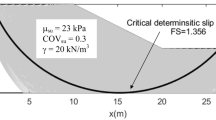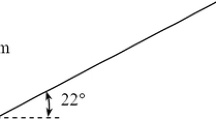Abstract
For successful design of any real-life engineering structures, it is important to quantify the risk of failure. Most of the geotechnical engineers find it suitable to define risk mathematically in terms of well-known metric called probability of failure. The inherent spatial variability of the soil strength parameters also makes the design of soil slopes suitable for stochastic interpretations. In the present study, probabilistic slope stability analysis has been performed for both, cohesive soil as well as cohesive frictional, i.e., \(c-\phi\) soil. The estimation of the factor of safety of the soil slope has been carried out using ordinary method of slices. Probabilistic analysis has been carried out using the single random variable approach with the assumption that the cohesion and angle of internal friction of soils follow lognormal distribution. The variation in soil shear strength is taken into account with the help of statistical parameter known as coefficient of variation. The effect of the coefficient of variation, the spatial correlation length, and local averaging on the probability of failure and the factor of safety has been investigated. This phenomenon indicates a gradual variation of probability of failure with respect to the factor of safety at higher coefficient of variation values. The presented analyses can be used to determine the factor of safety of a soil slope for which the slope should be designed with a predefined probability of failure.














Similar content being viewed by others
REFERENCES
Aladejare AE, Wang Y (2018) Influence of rock property correlation on reliability analysis of rock slope stability: from property characterization to reliability analysis. Geosci Front 9(6):1639–1648
Asteris PG, Mamou A, Hajihassani M, Hasanipanah M, Koopialipoor M, Le T-T, Kardani N, Armaghani DJ (2021) Soft computing based closed form equations correlating L and N-type Schmidt hammer rebound numbers of rocks. Transp Geotech 100588
Baker R, Garber M (1978) Theoretical analysis of the stability of slopes. Geotechnique 28(4):395–411
Bishop AW (1955) The use of the slip circle in the stability analysis of slopes. Geotechnique 5(1):7–17
Celestino TB, Duncan JM (1981) Simplified search for non-circular slip surface. Proceedings, 10th International Conference on Soil Mechanics and Foundation Engineering, International Society for Soil Mechanics and Foundation Engineering, Stockholm, AA Balkema, Rotterdam, Holland 3, 391–394
Chen L, Zhang W, Gao X, Wang L, Li Z, Böhlke T, Perego U (2020) Design charts for reliability assessment of rock bedding slopes stability against bi-planar sliding: SRLEM and BPNN approaches. Georisk: Assessment and Management of Risk for Engineered Systems and Geohazards, 1–16
Chen Z-Y, Shao C-M (1988) Evaluation of minimum factor of safety in slope stability analysis. Can Geotech J 25(4):735–748
Cheng YM (2003) Location of critical failure surface and some further studies on slope stability analysis. Comput Geotech 30(3):255–267
Cheng YM, Li L, Chi SC (2007) Performance studies on six heuristic global optimization methods in the location of critical slip surface. Comput Geotech 34(6):462–484
Dorigo M (1992) Optimization, learning and natural algorithms. Ph. D. Thesis, Politecnico Di Milano.
Drucker DC, Prager W (1952) Soil mechanics and plastic analysis or limit design. Q Appl Mathe 10(2):157–165
Fellenius W (1936) Calculation of stability of earth dam. Transactions. 2nd Congress Large Dams, Washington, DC, 1936, 4, 445–462
Fenton GA, Griffiths DV (2008) Risk assessment in geotechnical engineering (Vol. 461). John Wiley & Sons. New York
Fredlund DG, Krahn J (1977) Comparison of slope stability methods of analysis. Can Geotech J 14(3):429–439
Gao Y, Zhu D, Zhang F, Lei GH, Qin H (2014) Stability analysis of three-dimensional slopes under water drawdown conditions. Can Geotech J 51(11):1355–1364
Geem ZW, Kim JH, Loganathan GV (2001) A new heuristic optimization algorithm: harmony search. Simulation 76(2):60–68
Griffiths DV, Fenton GA (2000) Influence of soil strength spatial variability on the stability of an undrained clay slope by finite elements. In Slope stability 2000 (pp. 184–193)
Griffiths DV, Fenton GA (2004) Probabilistic slope stability analysis by finite elements. J Geotech Geoenviron Eng 130(5):507–518
Griffiths DV, Huang J, Fenton GA (2009) On the reliability of earth slopes in three dimensions. Proc R Soc A: Mathe Phys Eng Sci 465(2110):3145–3164
Griffiths DV, Lane PA (1999) Slope stability analysis by finite elements. Geotechnique 49(3):387–403
Griffiths DV, Yu X (2015) Another look at the stability of slopes with linearly increasing undrained strength. Géotechnique 65(10):824–830
Holand JH (1975) Adaptation in Natural and Artificial Systems 1975. University of Michigan Press, Ann Arbor, Mich
Jalal FE, Xu Y, Iqbal M, Javed MF, Jamhiri B (2021) Predictive modeling of swell-strength of expansive soils using artificial intelligence approaches: ANN, ANFIS and GEP. J Environ Manag 289:112420
Janbu N (1973) Slope stability computations–Embankment–Dam Engineering, Casagrande Volume. John Wiley and Sons, New York, pp 47–86
Javankhoshdel S, Bathurst RJ (2016) Influence of cross correlation between soil parameters on probability of failure of simple cohesive and c-ϕ slopes. Can Geotech J 53(5):839–853
Kaloop MR, Bardhan A, Kardani N, Samui P, Hu JW, Ramzy A (2021) Novel application of adaptive swarm intelligence techniques coupled with adaptive network-based fuzzy inference system in predicting photovoltaic power. Renew Sustain Energy Rev 148:111315
Kardani N, Bardhan A, Roy B, Samui P, Nazem M, Armaghani DJ, Zhou A (2021) A novel improved Harris Hawks optimization algorithm coupled with ELM for predicting permeability of tight carbonates. Eng Comput 1–24
Kardani N, Zhou A, Shen S-L, Nazem M (2021) Estimating unconfined compressive strength of unsaturated cemented soils using alternative evolutionary approaches. Transp Geotech 29:100591
Kennedy J, Eberhart R (1995) Particle swarm optimization. In Proceedings of ICNN'95-international conference on neural networks (Vol. 4, pp. 1942-1948). IEEE
Kirkpatrick S, Gelatt CD, Vecchi MP (1983) Optimization by simulated annealing. Science 220(4598):671–680
Lee KS, Geem ZW (2005) A new meta-heuristic algorithm for continuous engineering optimization: harmony search theory and practice. Comput Methods Appl Mech Eng 194(36–38):3902–3933
Matsuo M, Kuroda K (1974) Probabilistic approach to design of embankments. Soils Found 14(2):1–17
Morgenstern NRU, Price VE (1965) The analysis of the stability of general slip surfaces. Geotechnique 15(1):79–93
Nguyen VU (1985) Determination of critical slope failure surfaces. J Geotech Eng 111(2):238–250
Onyelowe KC, Iqbal M, Jalal FE, Onyia ME, Onuoha IC (2021) Application of 3-algorithm ANN programming to predict the strength performance of hydrated-lime activated rice husk ash treated soil. Multiscale Multidiscip Model Exp Des 1–16
Phoon K-K, Kulhawy FH (1999) Characterization of geotechnical variability. Can Geotech J 36(4):612–624
Sarma SK (1973) Stability analysis of embankments and slopes. Geotechnique 23(3):423–433
Skempton AW (1948) ‘The φ 0 Analysis of Stability and Its Theoretical Basis. Proceedings 72–77
Spencer E (1967) A method of analysis of the stability of embankments assuming parallel inter-slice forces. Geotechnique 17(1):11–26
Vanmarcke E (1983) Random fields. Random Fields 372
Wai FAH, Chen WAIFAH (1975) Limit analysis and soil plasticity.
Wang L, Wu C, Gu X, Liu H, Mei G, Zhang W (2020) Probabilistic stability analysis of earth dam slope under transient seepage using multivariate adaptive regression splines. Bull Eng Geol Environ 79(6):2763–2775
Wang L, Wu C, Tang L, Zhang W, Lacasse S, Liu H, Gao L (2020) Efficient reliability analysis of earth dam slope stability using extreme gradient boosting method. Acta Geotech 15(11):3135–3150
Whitman RV (1984) Evaluating calculated risk in geotechnical engineering. J GeotechEng 110(2):143–188
Wu W (2015) Slope Stability Assessment Based on Limit Analysis. In Geotechnical Safety and Risk V (pp. 263–268). IOS Press
Zhang W, Li H, Li Y, Liu H, Chen Y, Ding X (2021) Application of deep learning algorithms in geotechnical engineering: a short critical review. Artif Intell Rev 1–41
Author information
Authors and Affiliations
Corresponding author
Ethics declarations
Conflict of interest
The authors declare that there is no conflict of interest.
Additional information
Responsible Editor: Zeynal Abiddin Erguler
APPENDIX
APPENDIX
The probability of failure pf against slope failure has been defined as the probability that the Fs value is less than 1. The derivation of the expression of pf for different cases is shown below:
Cohesive Soil
For cohesive soil slope, the factor of safety Fs against failure is earlier mentioned in Eq. 11 and is given by
From Eq. A1, pf is derived as follows:
Taking logarithm on both sides, we get
Subtracting \(\mu_{{ln\left( {c_{u} L_{a} R} \right)}}\) and dividing by \(\sigma_{{ln\left( {c_{u} L_{a} R} \right)}}\) on both sides, we get
Cohesive Frictional Soil
In case of cohesive frictional, i.e., c – ϕ soil, different cases are considered in which soil properties such as cohesion and angle of internal friction are treated as lognormally distributed random variables. The respective expressions for factor of safety Fs against failure and the associated probability of failure are as described below.
For cohesion
In this case, the cohesion parameter is assigned lognormal distribution. The factor of safety Fs against failure is earlier mentioned in Eq. 14 and is given by
Further, the probability of failure pf expression from A3 is derived as follows
Subtracting \(\mu_{{\ln (\sum {cl} )}}\) and dividing by \(\sigma_{{\ln (\sum {cl} )}}\), we get
For angle of internal friction
In this case, the angle of internal friction is assigned lognormal distribution. The factor of safety Fs against failure is earlier mentioned in Eq. 15 and is given by
Further, the probability of failure pf expression from A5 is derived as follows
Subtracting \(\mu_{{\ln ((\sum {w\cos \alpha \tan \phi } ))}}\) and dividing by \(\sigma_{{\ln (\sum {w\cos \alpha \tan \phi } )}}\), we get
For both cohesion and angle of internal friction
In this case, both cohesion and angle of internal friction are assigned lognormal distribution. The factor of safety Fs against failure pf is earlier mentioned in Eq. 16 and is given by
Further, the probability of failure pf expression from A7 is derived as follows
Subtracting \(\mu_{{\ln (\sum {cl} + \sum {w\cos \alpha \tan \phi } )}}\) and dividing by \(\sigma_{{\ln (\sum {cl} + \sum {w\cos \alpha \tan \phi } )}}\), we get
Rights and permissions
About this article
Cite this article
Das, G., Burman, A., Bardhan, A. et al. Risk estimation of soil slope stability problems. Arab J Geosci 15, 204 (2022). https://doi.org/10.1007/s12517-022-09528-y
Received:
Accepted:
Published:
DOI: https://doi.org/10.1007/s12517-022-09528-y




